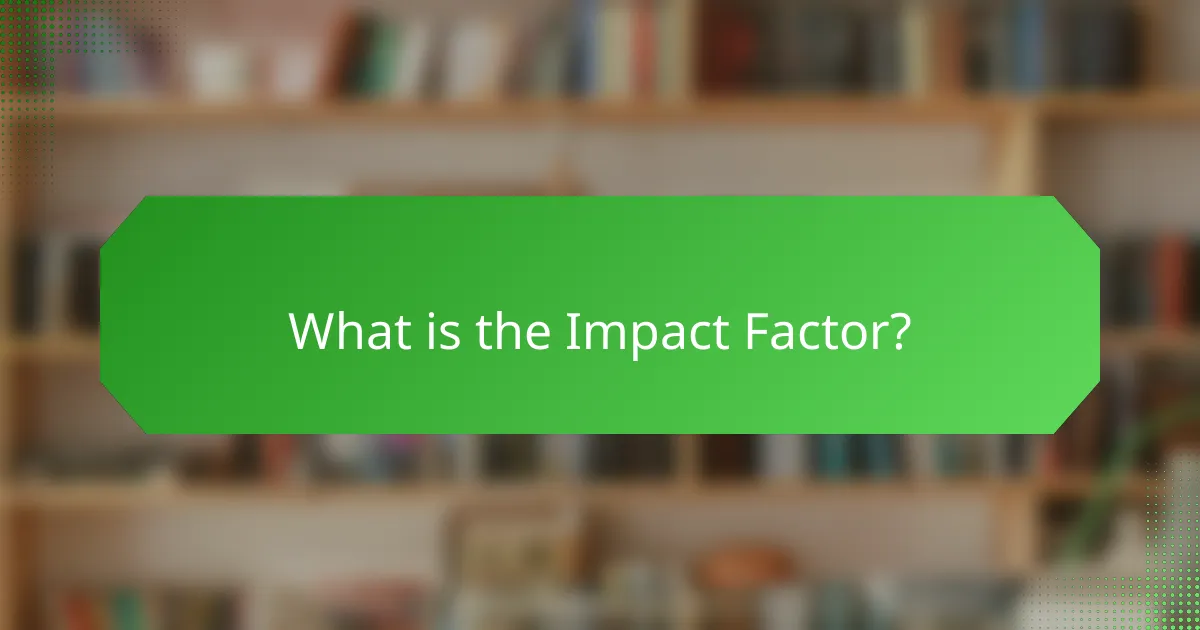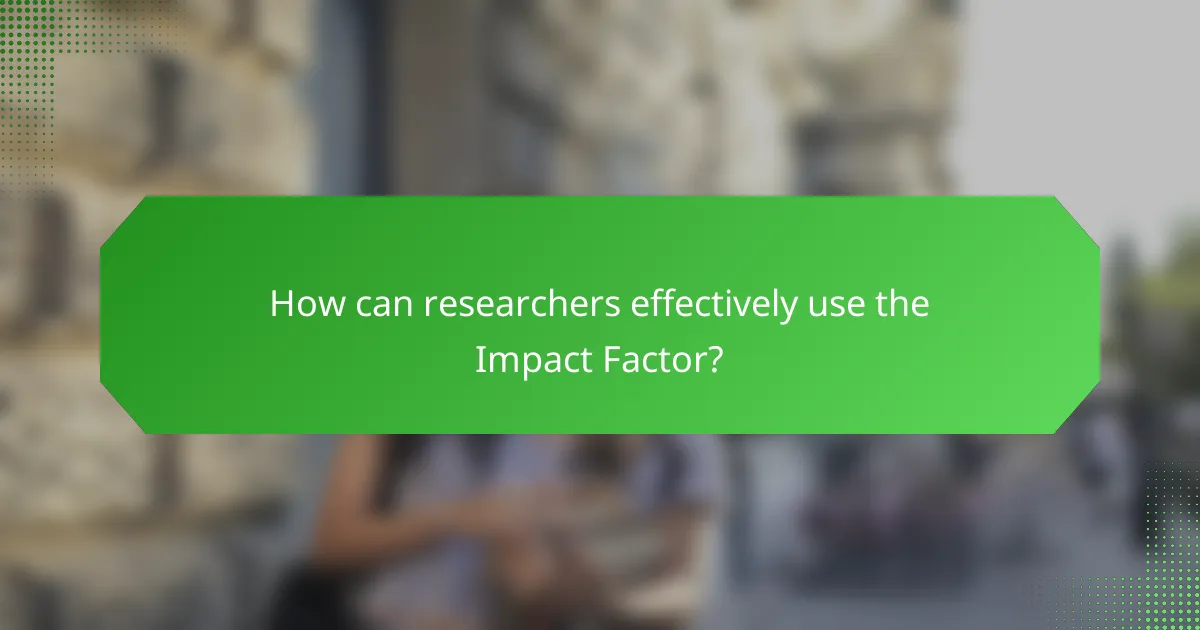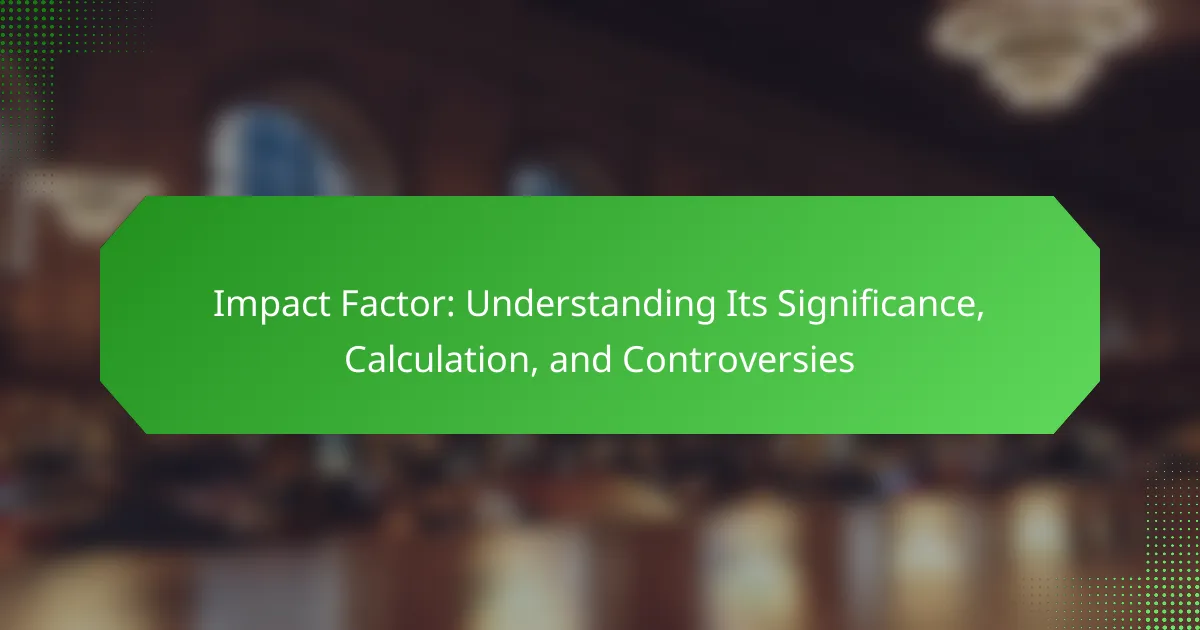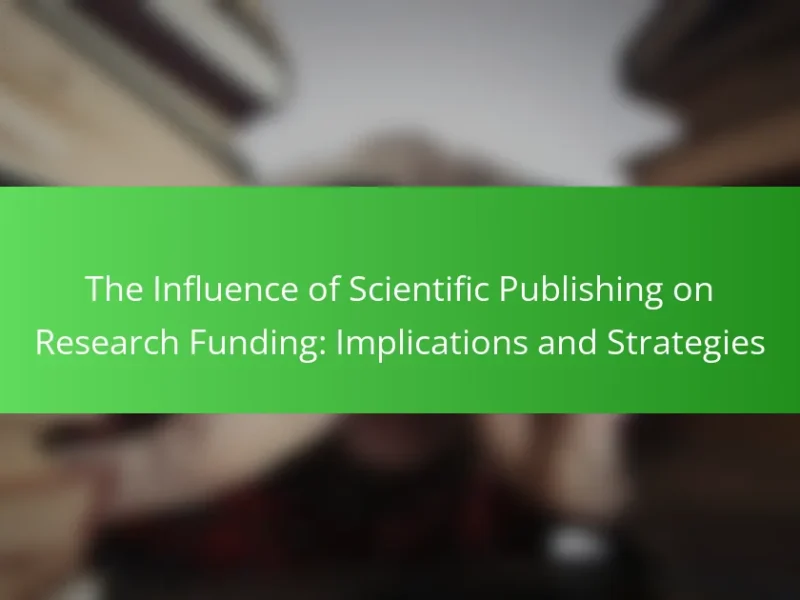The Impact Factor is a key metric used to assess the significance of scientific journals by measuring the average number of citations to their published articles over a specified period, typically two years. This article examines the calculation of the Impact Factor and its implications for evaluating journal quality, as well as its influence on researchers’ decisions regarding where to publish. It also addresses the controversies surrounding the Impact Factor, including its potential for misuse, limitations in reflecting true research quality, and biases it may introduce in academic funding and resource allocation. Additionally, the article emphasizes the importance of considering alternative metrics to achieve a more comprehensive evaluation of research impact.

What is the Impact Factor?
The Impact Factor is a metric used to evaluate the importance of a scientific journal. It measures the average number of citations to articles published in that journal over a specific period. Typically, the Impact Factor is calculated based on a two-year period. For example, a journal’s Impact Factor for 2022 is derived from citations in 2022 to articles published in 2020 and 2021. This metric helps researchers assess the relative quality and influence of journals in their field. Higher Impact Factors often indicate greater visibility and credibility within the academic community. The calculation is widely used in academia for journal selection and evaluation.
How is the Impact Factor calculated?
The Impact Factor is calculated by dividing the number of citations in a given year to articles published in the previous two years by the total number of articles published in those two years. For example, if a journal published 50 articles in 2021 and 2022, and those articles received 200 citations in 2023, the Impact Factor would be 4.0. This calculation provides a measure of the average number of citations to recent articles, reflecting the journal’s influence within its field. The formula is widely used in academic publishing to assess journal quality.
What metrics are used in the calculation of the Impact Factor?
The Impact Factor is calculated using two primary metrics: the number of citations and the number of articles published. Specifically, it measures the average number of citations received in a particular year by articles published in the previous two years. For example, if a journal published 100 articles in those two years and received 500 citations in the current year, its Impact Factor would be 5. This calculation is widely used to assess the influence and prestige of academic journals.
How does the time frame affect the Impact Factor calculation?
The time frame significantly affects the Impact Factor calculation by determining which citations and articles are included in the analysis. The Impact Factor is calculated by dividing the number of citations received in a specific year by the total number of articles published in the two previous years. This means that the selection of the time frame directly influences the citation counts and the number of articles considered. For example, if a journal has many articles published in the last two years that receive citations, its Impact Factor will be higher. Conversely, if fewer articles are cited, the Impact Factor will decrease. This calculation method emphasizes recent publications, thus making the time frame a critical factor in assessing a journal’s influence and relevance.
Why is the Impact Factor significant in academic publishing?
The Impact Factor is significant in academic publishing because it measures the average number of citations to articles published in a journal. This metric helps assess the journal’s influence and prestige within a specific field. A higher Impact Factor indicates that the journal’s articles are frequently cited by researchers. This can enhance the visibility and credibility of the published research. Researchers often consider the Impact Factor when choosing where to submit their work. It can also influence funding decisions and academic promotions. The Impact Factor is widely used in evaluations of academic performance. Therefore, it plays a crucial role in shaping the landscape of academic publishing.
What role does the Impact Factor play in journal reputation?
The Impact Factor serves as a key metric in determining journal reputation. It reflects the average number of citations to articles published in a journal. Higher Impact Factors typically indicate greater influence and prestige within the academic community. This metric is often used by researchers to assess where to publish their work. Journals with higher Impact Factors are perceived as more credible and authoritative. Thus, the Impact Factor can significantly affect a journal’s visibility and attractiveness to authors. It is important to note that while it is a widely recognized measure, it has limitations and should not be the sole criterion for journal evaluation.
How does the Impact Factor influence researchers and their work?
The Impact Factor influences researchers by affecting their publication choices and career advancement. Researchers often prefer journals with higher Impact Factors to enhance visibility. This preference can lead to increased citation rates for their work. Higher citations can improve a researcher’s reputation within the academic community. Furthermore, institutions may use Impact Factors to evaluate research performance. Funding bodies sometimes consider Impact Factors in grant applications. Consequently, the Impact Factor can shape research priorities and the direction of scientific inquiry. Studies show that journals with higher Impact Factors attract more submissions, indicating their perceived prestige.

What are the controversies surrounding the Impact Factor?
Controversies surrounding the Impact Factor include its potential misuse and limitations in assessing research quality. Critics argue that it encourages publication in high-impact journals over meaningful research. The metric can be skewed by self-citation practices, inflating scores artificially. Additionally, the Impact Factor does not account for the context of research or its societal impact. Some scholars assert that it favors certain disciplines, leading to bias in funding and resource allocation. Furthermore, reliance on this metric can undermine the diversity of scholarly communication. These issues highlight the need for alternative metrics to evaluate research effectively.
Why do some scholars criticize the Impact Factor?
Some scholars criticize the Impact Factor for its reliance on citation metrics. They argue it does not accurately reflect the quality of research. The Impact Factor can be skewed by self-citation practices. It may favor journals that publish review articles over original research. Additionally, the time frame for calculating the Impact Factor can distort the significance of citations. Scholars also note that it encourages publication in high-impact journals rather than diverse outlets. This can lead to a narrow dissemination of knowledge. Research by Seglen (1997) highlights these issues, pointing out that the Impact Factor can mislead evaluations of scientific merit.
What are the limitations of the Impact Factor as a measure of quality?
The Impact Factor has several limitations as a measure of quality. It primarily reflects citation frequency, not the actual quality of research. The measure can be influenced by the size of the journal and its field. Journals with larger audiences may have higher Impact Factors regardless of content quality. Additionally, it does not account for the context of citations. A citation may not indicate endorsement of quality. Furthermore, the Impact Factor can be manipulated through self-citations or publishing strategies. It also does not consider non-cited articles that may be influential. Lastly, it ignores the diverse nature of scholarly outputs across disciplines.
How does the Impact Factor impact publication practices?
The Impact Factor significantly influences publication practices by prioritizing journals with higher metrics. Researchers often choose to submit their work to journals with elevated Impact Factors. This trend can lead to a focus on quantity over quality in research. Studies show that high Impact Factor journals attract more submissions. Consequently, this affects the peer review process and publication timelines. Many institutions also consider Impact Factor in tenure and promotion decisions. This reliance on Impact Factor can create pressure on researchers to publish in prestigious journals. Overall, the Impact Factor shapes the landscape of academic publishing and research dissemination.
What alternative metrics exist to assess journal quality?
Alternative metrics to assess journal quality include the h-index, citation analysis, and article influence score. The h-index measures both productivity and citation impact of a researcher or journal. Citation analysis evaluates the frequency and context of citations to articles within a journal. The article influence score calculates the average number of citations to articles published in a journal over a five-year period. These metrics provide a more comprehensive view of journal quality beyond traditional impact factors. Research shows that using multiple metrics can lead to a better understanding of a journal’s influence and reputation within its field.
How do these alternatives compare to the Impact Factor?
Alternatives to the Impact Factor, such as the h-index and CiteScore, provide different metrics for assessing journal quality. The h-index measures both the productivity and citation impact of an author’s publications. CiteScore calculates the average citations per document published in a journal over a three-year period. Unlike the Impact Factor, which is based on a two-year citation window, CiteScore offers a broader timeframe. The h-index is author-specific, while the Impact Factor focuses on journal-level metrics. Furthermore, alternatives like Altmetric score consider social media mentions and online engagement, expanding the evaluation beyond traditional citations. These differences highlight the limitations of the Impact Factor and the need for diverse metrics in academic publishing.

How can researchers effectively use the Impact Factor?
Researchers can effectively use the Impact Factor to evaluate journal quality. The Impact Factor measures the average number of citations to articles published in a journal. It helps researchers identify reputable journals for submission. A higher Impact Factor often indicates greater visibility and influence in the field. Researchers should compare Impact Factors across similar journals to make informed decisions. They can also use it to assess the potential reach of their work. However, researchers must consider other metrics alongside Impact Factor for a comprehensive evaluation. Relying solely on Impact Factor may not reflect the true quality of research.
What strategies should researchers consider when selecting journals based on Impact Factor?
Researchers should prioritize journals with a high Impact Factor for visibility. They should assess the relevance of the journal’s scope to their research field. It is essential to consider the journal’s audience and readership. Researchers should also evaluate the journal’s acceptance rate and review process duration. Understanding the journal’s editorial board can provide insights into its credibility. Analyzing the citation patterns of articles published in the journal can indicate its influence. Researchers should be aware of the potential for bias in Impact Factor metrics. Finally, consulting colleagues and mentors can offer valuable perspectives on journal selection.
How can understanding the Impact Factor improve publication success?
Understanding the Impact Factor can significantly enhance publication success. The Impact Factor measures the average number of citations to articles published in a journal. Higher Impact Factors often indicate greater visibility and prestige for journals. This visibility can lead to increased submission rates from authors. Authors may choose to submit their work to higher Impact Factor journals for better recognition. Research shows that articles in high Impact Factor journals tend to receive more citations. This is crucial for academic advancement and funding opportunities. Thus, understanding and targeting journals with favorable Impact Factors can improve an author’s chances of publication success.
What best practices should be followed regarding the Impact Factor in research evaluation?
Best practices regarding the Impact Factor in research evaluation include using it as one of multiple metrics. Relying solely on Impact Factor can lead to biased assessments. Researchers should consider the context of the journal’s field. The Impact Factor varies significantly across disciplines. Evaluators should also incorporate qualitative assessments of research quality. This includes examining the content and relevance of the articles. Additionally, it is essential to recognize the limitations of the Impact Factor. It does not account for individual article citations. Using a diverse set of metrics provides a more comprehensive evaluation of research impact.
The Impact Factor is a critical metric used to assess the significance of scientific journals by measuring the average number of citations to articles published within a specific timeframe. This article explores the calculation of the Impact Factor, its significance in academic publishing, and its influence on researchers’ publication choices. Additionally, it addresses controversies surrounding the metric, including its limitations and potential misuse, while also presenting alternative metrics for evaluating journal quality. Understanding the Impact Factor is essential for researchers aiming to enhance their publication success and navigate the academic landscape effectively.


